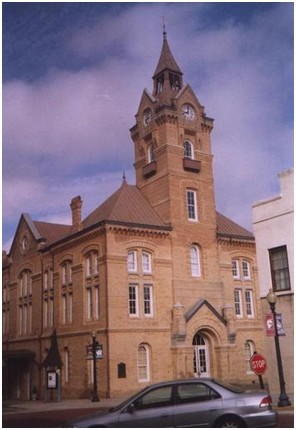

The Newberry Opera House, located in Newberry, South Carolina, is a fully restored historic building that is a live-performance space for popular artists, touring theatre companies, the South Carolina Opera Company and the Asheville Lyric Opera. It is listed on theNational Register of Historic Placesin 1969.[1]
Designed in the French Gothic style, the first floor of the building was used by the town government for offices, a jail, and the fire company, which had one engine there. The upper floor was designed as a theater and supporting spaces. For years it attracted national touring companies, individual performers and a variety of theatre acts. It later was adapted also for use as a movie theater, but showed its last movie in 1952. It was restored beginning in 1944, in a project that included an addition to enable its use for full theatrical productions.
History
The building was designed in the French Gothic style as both a place of entertainment and as a seat of government for the city. The building, completed in 1881, had a clock tower 130 feet (40 m) topped with a garfish weather vane.
The original design called for the first floor to house the fire engine room, town council chambers, a clerk’s office, a police officer, and three jail cells. The second floor contained a hall with 426 seats, 53 by 52 feet (16 m) in size. Also on this floor were a ticket office, a "green room", a cloakroom, and three dressing rooms. Drop curtains and seven scenes or sets for the stage were available. One scene, a landscape, survived to the late 20th century.
The Opera House quickly became known as "the entertainment center of the Midlands". Touring companies of New York plays, minstrel and variety shows, famed vocalists and lecturers, magicians and mind readers, novelty acts and boxing exhibitions all were featured there. It was used not only by professional performers, but also by the community for meetings, dances, college commencement exercises, and musicals. Notable artists, such as Edwin Booth, John Barrymore and his family, and Tallulah Bankhead are known to have performed there.
The first film shown there was Birth of a Nation (1915), a silent movie, and others followed. The early Edison “Talkies," using a phonograph record for sound, were introduced in the 1920s. Slowly, movies replaced the stage shows. In the 1920s, the Opera House was remodeled as a movie theater.
In 1952, after the showing of The Outlaw, the Opera House was closed as a movie theater. Around that time, the original horseshoe-shaped balcony was replaced was reduced in size and restricted to seating across the back of the auditorium for blacks only; the state had racial segregation in facilities. The city added an outdoor open stairway which they required blacks to use for entry. Since the mid-1960s, such public facilities have been integrated.
By 1959, there was talk about tearing the building down, but the hall was still used for community purposes, and the city used the first floor. In 1969 theNewberry Historical Society promoted the preservation of the Opera House, as did several other community groups. In 1970 the building was placed on theNational Register of Historic Places.
After the City of Newberry vacated the building in 1992, the Newberry Opera House Foundation was established to assess restoration. Recognizing the lack of performance spaces in the Midlands, it consulted with experts about a proposed project. Since proceeding with a restoration plan, it has managed fundraising and operations of the facility, which it leases from the city.
The exterior restoration and window replacement were completed in 1994, and the interior renovation was begun in 1996. It included restoration of the horseshoe-shaped balcony. An additional 10,000 square feet (930 m2) was added to the original building in order to create a full theatrical production facility: a new loading dock, an elevator, a second stage for rehearsal, and dressing rooms. The total cost of the renovation was approximately $5.5 million. Architects for the renovation and addition were Craig GauldenDavisof Greenville, South Carolina.
A variety of theatrical touring companies and live-performance artists, the Newberry Ballet Guild, South Carolina Opera Company and Asheville Lyric Operaall perform here, keeping the hall busy. It has a maximum capacity of 426. It is also used for performances by Newberry College and other community institutions.



















